'The Pearson' Model of the Church of the Holy Sepulchre, Jerusalem
A Rare and Important Model of the Church of the Holy Sepulchre, 'The Pearson' model. Jerusalem Carved from olive wood, inlaid with ebony and ivory and profusely engraved mother of pearl on the flat roofs, the four points of the compass are shown by the words ‘Meredies, Oriens, Septembrio, Ponens’ in engraved mother of pearl. The roofs, domes and walls can be removed to reveal the interior and its relics Sold together with eight separate disassembling models of the Chapels, Shrines and Sepulchres that comprise the most important pilgrimage sites of the Holy Mountain, Calvary and Tomb. Carved in Olive wood and inlaid with mother of pearl engraved with holy scenes and figures 17th Century Size: 30cm high, 44cm wide, 38cm deep – 11¾ ins high, 17¼ ins wide, 15 ins deep (main model) – please contact for detailed measurements of chapels
The City of Jerusalem is unique in being sacred to three religions: Judaism, Islam and Christianity. The Roman Emperor Constantine 1 built the original Church of the Holy Sepulchre in 325 AD. It was built to contain the reputed tomb of Christ the Holy Sepulchre, the site of the crucifixion Golgotha, and the grotto where St Helena discovered the cross known as St Helena’s Crypt. The Anastis, resurrection Rotunda enclosed the tomb. The Church was magnificently decorated with marble walls and a coffered ceiling painted in gold. There are now only scattered remains of the Constantinian Holy Sepulchre.
The church was defaced and damaged by the Saracens and the Persians and was virtually destroyed in 1009. In July 1099 the Crusaders conquered and occupied Jerusalem and their first act was to massacre all the Muslim inhabitants. Their second was to rebuild, enlarge and embellish the small ancient Church that was the site where Christ died and was buried. The architecture resembles that of 12th century Sicily and it is thought workmen were brought from the island to work on the Church of the Holy Sepulchre.
The building was again partially destroyed in 1808 by a disastrous fire when almost the entire eastern portion was consumed and the great dome fell in crushing beneath it the Chapel of the Holy Sepulchre. All of the marble columns and images were calcined and reduced to powder. Thus this model represents the Church as it stood prior to this destruction and not as it appears today.
As a holy city from the time of Constantine the Great, Jerusalem attracted scholars and pilgrims, but after the discovery and excavations of the Holy Christian sites it became an important focus of pilgrimage. In 1335 the Franciscans returned to the city and numerous churches, monasteries and their associated hospices were built to care for and accommodate the thousands of Christian pilgrims.
The opportunities for tourism that this influx presented was immense and this model is an elaborate, exotic and costly example of a souvenir made to satisfy the still vital pilgrimage market of the 17th century, although by then the holy city had also became an important Grand Tour destination for the wealthy Princes and aristocracy of Europe.
Transcript of Country Life Article relating to Model of Church owned by Captain Pearson:
COUNTRY LIFE April 22nd, 1905
THE CHURCH OF THE HOLY SEPULCHRE
Flushes with victory, bare-footed, and singing hymns of praise for the downfall of the infidel, he conquering Crusaders entered he Church of the Holy Sepulchre at Jerusalem in the year 1099. Finding it too small for their numbers and too insignificant for their taste, they enlarged and beautified it; and thus it remained with but little alteration until the disastrous fire of 1808, when almost all the eastern portion of the building was consumed, when the great dome fell in, crushing beneath it the Chapel of the Holy Sepulchre, and the marble columns and images were calcined and reduced to powder. That the model here shown represents the church not as it appears at the present day, but as t stood prior to this terrible destruction, adds interest to the picture, especially for those who may have recently visited the Holy Land, and who can compare the church as they have seen it with that which formerly existed.
Made of olive-wood, inlaid with ivory and mother-o'-pearl, this wonderful model is the reputed work – a work of labour and of love – of holy men in a monastery at Jerusalem. It is carefully preserved by its present owner, Captain George Pearson of Stoke Albany House, Market Harborough, whose ancestor, Mr Ashby, a Turkish merchant, brought it to England in the seventeenth century, and who handed it down as a rare possession to his descendants. A fac-simile of this model is in the Bodleian Library at Oxford, and the writer believes there are two others in existence.
In the first illustration is seen the outside of the building, with its domes, its tower for the bells, its flat roofs, on which the four points of the compass are shown by the words 'Meredies,' 'Oriens,' 'Septemtrio,' 'Ponens,' inlaid in ivory. These roofs and domes bing removed, the interior, with all its wonderful relics, is exposed to view, as shown in the second picture.
A parchment scroll (a legible copy of which is appended) accompanies the model, and gives, in ancient writing and quaint spelling, a full description of each part of the building. These are numbered to correspond with numbers on the model, making it easy to follow the plan and to find the various chapels shrines, and sepulchres within the walls. That many of these no longer exist must be a matter of regret. The tombs of 'Godfrey and Baldwin, Christian Kings,' which formerly stood in the south transept close to the great south entrance, disappeared after the fire, whilst others, no doubt fell a prey to the flames. In the centre of the Rotunda, whose dome formerly rested on twelve large columns, but which now has eighteen piers carrying a clerestory with a dome open at the top, still stands the shrine of the Holy Sepulchre, just as it did of old, its western end polygonal and its eastern end square. Here is performed that strange rite of 'Holy Fire' which celebrates the Greek Easter, when the huge building is packed with pilgrims, thousands encircling the shrine and thousands lining the walls, whilst between these two masses of humanity a lane is formed and kept open by Turkish soldiers. Dean Stanley thus describes this curious scene: “It is about noon when this circular lane is suddenly broken through by a tangled group rushing violently round till they are caught by one of the Turkish soldiers. It seems to be the belief of the Arab Greeks that unless they run round the sepulchre a certain number of times the fire will not come. Possibly, also, there is some reminiscence of the funeral games and races round the tomb of an ancient chief. Accordingly, the night before, and from this time forward for two hours, a succession of gambola tales place, which an Englishman can only compare to a mixture of prisoner's base, football and leapfrog, round and round the Holy Sepulchre. . . . Some are dressed in sheepskins, some almost naked, one usually preceding the rest as a fugleman, clapping his hands, to which they respond in like manner, adding also wild howls, of which the chief burden is: 'This is the tomb of Jesus Christ!' 'God save the Sultan!' 'Jesus Christ has redeemed us!'â€
By and by the course is cleared for the procession, in which embroidered banners are carried; it files three times around the Sepulchre. At the third round the Turkish soldiers join in, and consent to be driven out of the building, yielding to the superstition that the descent of the Holy Fire is delayed by their presence. A wild confusion follows as the crowd closes in, banners topple over, bishops and priests fly; but by this time the 'Bishop of Fire' has gained the Chapel of the Holy Sepulchre and the door is shut. Close to the hole in the wall stands the priest ready to catch the fire, which is presently ignited, as the pilgrims believe, by God Himself descending upon the Holy Tomb. Every upraised hand amongst that mighty multitude holds a taper, and one by one they catch the light till the whole assembly seems on fire, till the atmosphere becomes unbearably oppressive, and a wild rush is made towards the entrance. Then through their midst 'the Bishop is carried out of the chapel in triumph on the shoulders of the people in a fainting state, to give the impression that he is overcome by the glory of the Almighty from Whose immediate presence he is supposed to come.'
COPY OF PARCHMENT SCROLL
A DESCRIPTION OF THE RELIQUES WHICH ARE IN THE TEMPLE OF THE SEPULCHRE OF OUR SAVIOUR, JESUS CHRIST, IN JERUSALEM.
1. The great gate of the Temple of the Holy Sepulchre.
2. The tower for the bells.
3. The Abissines Chapel.
4. The chapel of the Holy Mountain Calvery. Where stood the Virgin Mary when they crucified our Saviour, Jesus Christ. It is in the hands of the Franciscan fathers.
5. The place and stone where our Saviour was anointed before his burial.
6. The sepulchres of Godfrey and Baldwin, Christian Kings.
7. The sepulchres of other Kings and Christian Kings.
8. The place where the Virgin Mary stood when our Saviour was anointed.
9. The stairs which lead to the Armenians.
10. The Armenians' habitation.
11. The Armenians' Church.
12. The Armenians' Altar.
13. The gate which leads to the Abyssines.
14. The ancient caves which they see in this place.
15. The sepulchres of Joseph of Arimathea and Nicodemus.
16. The gate which leads to the Syrian Church.
17. The stone on which the Angel appeared to the two Marys and said: 'He is risen, He is not here.'
18. The Holy Sepulchre of our Saviour on which no nation can say masses except the Francescans.
19. The Greek Altar.
20. The Greek Church.
21. The place in the midst of the said church where they say is the midst of the world.
22. The icon of the said church.
23. The crucifix in the said church.
24. The altar in the said church.
25. The gate which leads to the common cistern.
26. The place where Christ appeared to Mary Magdalene in manner of a gardener.
27. Mary Magdalene's Chapel belonging to the Francescans.
28. The gate where they enter the Francescan Church.
29. The place where a dead man was raised again by virtue of the Holy Cross.
30. The altar in the said church belonging to the Francescans where is the pillar where our Saviour was whipped, and a piece of the pillar of Repwoarth and of the Holy Sepulchre.
31. The great altar of the said church where is kept the Holy Sacrament.
32. An altar in the said church where for a time was part of the Holy Cross.
33. The gate which leads to the Francescan habitation.
34. The gate which leads to the necessary houses.
35. The chapel where they say our Saviour was in prison, in the Greek's possession.
36. The gate which leads to the Greek Church.
37. The chapel enstyled 'Longinus,' which belongs to the Armenians.
38. The chapel of the dividing our Saviour's garments, in the hands of the Armenians.
39. The gate which descends to St Helena's Chapel which is in the hands of the Armenians and the gate where St Helena found the 'Holy Crosses,' which is in the hands of the Francescan fathers.
40. The chapel where was a part of the pillar of Repwoarth. It was the Abyssines, but at present it is in the hands of the Greeks.
41. The gate that leads to the Greek church.
42. The stairs that lead to the Holy Mountain Calvery.
43. The bridge which passeth by the said stairs to the Holy Mountain Calvery.
44. The cleft in the rock of the Holy Mountain Calvery, which opened when our Saviour gave up the Ghost.
45. The hole where was fixed the Holy Cross with our Saviour.
46. The place where our Saviour was crucified.
47. ................................................(obliterated).
The Virgin was when they crucified our Saviour.
____________________
Transcript of an Article which appeared in The Times, January 30, 1929
THE TIMES
January 30, 1929
CHURCH OF THE HOLY SEPULCHRE
DISCOVERY OF A MODEL
(From our art critic)
A discovery of archaeological interest has been made by Mr Roy Bishop – assistant secretary of the British Artists' Exhibitions, founded by Sir Joseph Duveen – in the shape of a model of the 'Church of the Holy Sepulchre at Jerusalem before its partial destruction by fire in 1808. Together with an old letter book describing it and its history the model was found in the house of a descendant of Oliver Cromwell. There is a similar model in the Bodleian Library in Oxford, but in a comparison of photographs that found by Mr Bishop appears to be more complete, finer in construction, and more delicate in detail. Yet a third model, is said to exist in Russia, and it seems probable that all three were made at the same time – during the early 18th century. The latest find is of wood inlaid with mother-of-pearl. All the parts are numbered with reference to a descriptive list, and the model can be unroofed to show the plan of the building.
The model was brought from the Holy Land in 1763 by William Frankland, and is described in the old letter book as
'a very curious and compleat Model adorn'd with Mosaic Work in Mother of Pearl, &c., of the whole Temple of Christ's Sepulchre at Jerusalem, as it was built by Helena Mother of the /Emperor Constantine, with all the Chapels, Altars, and other observable Buildings about it, from the showing whereof the profits arising have been Farmed (sic) at above £3,000 sterling pr. Annum, this venerable curiosity is so artificially contriv'd, that the inside and ground Plan is rendered as visible as the elevation; all the particular places of parts in the said Model are distinctly number'd, which numbers are exhibited together with their explanations in the following Tables.'
Then follows a list of 47 entries, describing the different parts of the building, and giving the positions traditionally assigned to Our Lady, St Mary Magdalen, and others in the events of the Passion. The plan, it may be said, is substantially the same as that in the Ordnance Survey of 1864.
A brief summary of the history of he Church of the Holy Sepulchre may be added. About A.D. 135 the Emperor Hadrian built a temple dedicated to Venus – or possibly Astarte Syriaca, the Syrian Venus – upon the supposed site of the Sepulchre. Whether the site was chosen by accident or to slight Christianity is not known. Constantine became Emperor, in 306, and was converted to Christianity six years later. After the great Council of the Church in 325 he decided to find the sites of the Crucifixion and the Resurrection. The task was entrusted to Bishop Macarius, who found the Sepulchre under the temple of Venus. Constantine had the temple removed, to discover a rock-hewn Jewish tomb and another cavity 280ft. to the east of it containing the three Crosses. Two churches were built, one over the Tomb and the other over the cavity of the Crosses, with the small hill of Mount Golgotha between, and the ground was levelled and surrounded with porticoes or colonnades. In the Church of Santa Pudenziana, Rome, there is a mosaic, supposed to be of the fourth or fifth century, which shows the churches, and they are represented again in another ancient mosaic, discovered in 1897, in a church at Madeba, east of Jordan. The Church of the Crucifixion seems to have disappeared early in the various Persian and Saracen occupations, but after the capture of Jerusalem by the Crusaders in 1099 the Church of the Tomb was repaired and enlarged with the addition of a nave and chancel to the circular building, and so it remained, with periodical restorations, up to 1808, when it was greatly damaged by fire. Writing in 1847, James Fergusson questioned the site of Constantine's Church, which he identified with the Dome of the Rock, but both physical geography and the evidence of the mosaics are against him.
It is hardly necessary to say that the model discovered by Mr Bishop represents the work of the Crusaders and not the Church “as it was built by Helena Mother of the Emperor Constantine,†as claimed in the old letter-book. Architecturally it is interesting as showing the earliest phase of the transition to Gothic from Byzantine Romanesque.
____________________
Quote from Exhibition catalogue, 1965 V&A Museum
Church of the Holy Sepulchre, Jerusalem.
One of the six models of the Church, made for the six members of the Court who apportioned the different parts of the Church o the Latin, Greek and Armenian Churches in the 19th. Century.
The only other of this set of models whose whereabouts is known is at Burghley House in Northamptonshire.
The model can be taken to pieces, to show the position of very part of the building. It is a good example of work in mother-of-pearl, done at Damascus.
Photograph of similar model belonging to R H Pearson Esq. Exhibited at Exhibition of 'The World of the Bible' at the Victoria and Albert Museum in London, October 1965.
“One of many models of the Church of the Resurrection (less correctly known as the Church of the Holy Sepulchre) made by craftsmen at Bethlehem under the supervision of the Franciscans or by the Franciscans themselves. At least four examples have survived in England...This Church is shown as it was between 1554 and 1719. The making of the models began before 1598.†A.D. 1600-1700.
(Quoted from Exhibition Catalogue)
____________________
Communication with Jon Culverhouse (Curator, Burghley House, Stamford, England) May 2009
Copy of correspondence between Mr Jon Culverhouse and E. Vandevyvere May, 1997:
INFO: MISCELLANEOUS 1997
Ernest VENDEVYVERE Bruges, 26th may 1997
Brugge
Dear sir, dear lady,
On 12th may 1997, in the company of my wife and of some friends, I paid a visit to Burghley House, and we were gently guided by a lady. I told her that I was a town-guide in Bruges.
May I ask you please, to hand her over the present letter and enclosured copies, treating of pieces of art, displayed in your very interesting collection.
1. Scale-model of the Chapel of the Saint Sepulchre.
Copy from the cover of a catalogue
Translation of the cover:
'Town of Bruges. Donation by M. OLBRECHTs-MAURUSSENS. Mother of pearl from 16th tot 20th C. Museum Arensthuis, Dijver 16, Bruges, temporary exhibition 7th dec. 1984 - 27th january 1995.'
Translations of texts about that scale-model.
'...the Brugean museums got from mrs M. Olbrechts – Maurissens an important donation of 900 objects made of mother of pearl ... Mrs. Olbrechts – Maurissens was living in Antwerp, she was the widow of the famous flemish ethnologue Frans Olbrechts, born in Mechelen on 16th efbr. 1899 and deceased in Aken on 14th march 1958 ...
.......
Scalemodels of the Chapel of the Saint Sepulchre in Jerusalem are something special.
These very precious works of art, of which at the moment about 15 specimens exist, scattered over the world, were carved out during the 17th and 18th C., in olive-wood and inlaid with mother of pearl and ivory. They belong to the products, made by the Franciscan order, who owned a complete chain of workshops in old Palestine. They were sold as souvenirs for those who desired to keep a remaining memento of their pilgrimage to the Holy Land. The model that Bruges received some time ago, and a second identical specimen, preserved in the Museum of the Beguinage in Turnhout, are the only Chapels in the Saint Sepulchre to be found in Belgium. Just like it is the case with most of the other specimens, they can completely be pulled by pieces. All existing architectural elements are rended, even to the most extreme details, and provided with the necessary Latin inscriptions.
All texts and letter have a clear meaning and refer to the present situation of the world-famous and often visited monument. What this concerns, it is interesting to mention that there exist some models of the Chapel of the Saint Sepulchre, provided with a document on parchment, on which a complete description of each part of the building is given. In the centre, there is of course the Saint Sepulchre of Christ, that was damaged in the beginning of the 4th C., but later on reconstructed on the foundations, dating from the period of Constantine the Great. Round the Sepulchre, there is an octagonal building erected and all that is decorated with half-columns. Almost identical or similar specimens of the Chapel of the Saint Sepulchre are to be found in the musea in London, Hamburg, Munich, Augsburg, Utrecht, Kopenhagen, and also in cloisters and private collections abroad. .......'
('abroad' : in this tixt = outside Belgium)
Hoping to please you with these information’s, I greet you very respectfully.
Yours sincerely
E. VANDEVYVERE
____________________
Notes From Jon Culverhouse, Burghley, May 2009:
MODEL OF THE CHURCH OF THE HOLY SEPULCHRE
The following is all that is known to the holder regarding the Model of the Church of the Holy Sepulchre, at present in the ownership of Mrs B M L Hutton of 'Maesgwilym', Rhyl. It came to her indirectly from her Aunt, Miss Maria Slater, a copy of whose notes are given below.
The following is a copy of the original book belonging to the model of the Church of the Holy Sepulchre at Jerusalem:-
'The Empress Helena having, as it has been said, found the Cross at Jerusalem built this magnificent Church over the Holy Sepulchre. The roof was of cypress and, the King of Spain giving a new one, what remains of the old roof is considered as religious and made beads of to this day. There is a hole in the top of the dome to give light as in the Pantheon at Rome. The gallery above is about three-quarters of a circle, the opening to the Greek Church being the other part. The greater part of the gallery belongs to the Latins. They have no entrance to it from their Convent. The part of the Church under the gallery is enclosed and belongs to the people of different religions.
The Church is about 100 paces long and 60 paces wide. That part called Mount Calvary is 21 steps higher that the common floor of the Church.
As the Church doors are commonly kept shut the Latins receive their provisions at a window in the door, they having no entrance to the Convent but by the Church.
The Sepulchre was at first only a hole cut in a solid rock under ground but the rock is since hewn and cut away all round and it now appears like a grotto above ground and is cased with grey marble on which is a fine inscription.
For further particulars refer to Porveks (?) description of the East – published by Bower in 1745 – see his plans and account of the Holy Sepulchre and the Church that was built over it by the Empress Helena (pages 15 and 16), also to Sandys travels 7th edition printed by Williams – London, 1673.
This model is mentioned by Shaw to his History of Staffordshire, then in the possession of C Jolland Esq., of Barton under Neechwood'.
This copy of the old book was made by me – Maria Slater, Bournemouth (1924).
---------------------------------------------
The following was copied by Herbert Speakman from 'History and Antiquities of Staffordshire – 1898' by Rev. Slebbing Shaw – Volume 1, page 116.
'At Mr Jolland's house, a little below this, is a curious and beautiful model of the Holy Sepulchre and Church built over it, purchased by Charles Jolland Esq., at the late Mr Smith's repository in the Old Playhouse, Lincoln Inn Fields, London, in the year 1764.
the model is of fine wood (unknown to every artist Mr Jolland has met with – he thinks it shittim wood, such as Noah's Ark was composed of) curiously inlaid with ivory and mother-of-pearl.
The particulars respecting it are supposed to have been lost on Mr Smith's decease.
Mr Jolland knows not whence Mr Smith met with it nor the date of its antiquity, neither the name of the ingenious artist.
This Church goes by the name of 'The Temple of Christ's Sepulchre'. It is about 100 paces long and 60 wide.'
The History from which this was extracted in 1890 was in a Manchester Public Library.
----------------------------------------------------
Early in the 19th century the model came into the possession of Mr John Sherratt, and his widow (who was Maria Sister before her marriage) willed it to her brother William Slater, Solicitor, then living at Higher Broughton, Manchester. He died at a great age about 1890. The model then came to Alice and Maria Slater, his nieces.
----------------------------------------------------
There is a very similar model owned by Charles Trevelyan, Wellington Cambo, Morpeth.
-----------------------------------------------------
The Key of Jerusalem is the Holy Sepulchre – no one can stoop and enter that narrow place without the deepest emotion. It is the holiest spot in the world. It is almost certainly genuine but it is not the reverence of centuries of devotion makes it hallowed for us. So it is with all the chapels by which it is surrounded. If they are not what they declare of myriads who have been worshipped in that belief.'
Upcar Browning
After finding of the Holy Cross and Sepulchre by the Empress Helena, mother of Constantine.
AD.326 The Church built over the Sepulchre by Constantine, Emperor of Rome.
AD.335 The Church consecrated.
AD.614 The Church destroyed by Persian invaders and soon after rebuilt.
AD.830 Partly destroyed by Arabs.
AD.1099 Rebuilt by Crusaders.
AS.1149 Completed by Maitre Jourdain. This is the Church of which the model is a copy.
AD.1808 The Church was gutted by fire – and partly restored.
AD.1868 Again restored by the French and Russians – and it is still in essence the Cathedral of the Crusaders.
----------------------------------------------
GUIDE TO THE MODEL OF THE CHURCH OF THE HOLY SEPULCHRE
1. The entrance.
2. The tower of the church.
3.
4.
5. The stone on which Our Saviour's Body was anointed for His burial.
6. Where the garments were divided by lot.
7. The tombs of the four kings were carried to Christendom when the Saracens took the city.
8. The pillar on which Christ was scourged.
9. The ascent to the rooms belonging to the Latins.
10. A room belonging to the Latins.
11. A room belonging to the Latins.
12.
13.
14. The cave of Joseph of Arimathea.
15. The sweating pillars.
16. The stone that was rolled against the door of the Sepulchre.
17. The Sepulchre.
18. The opening to the Greek choir.
19. The centre of the earth.
20. The High Altar.
21. The Chapel of Derision.
22.
23. Where Isaac was offered.
24.
25.
26. Where they kept the altar of Melchizedeck.
27. The Sepulchre of Baldwin and Godfrey, kings of Jerusalem.
28. The altar of the Holy Cross.
29.
30. The prison of Christ.
31.
32. The Chapel of the Division of Christ's Garments.
33.
34.
35. Ascent of Mount Calvary.
36. A gallery to -------
37. Where the bad thief was crucified, and divided from Christ by a cleft in the rock.
38. Where Christ was crucified.
39. Where He was nailed to the cross.
40. The Chapel where the Blessed Virgin went to see Christ on the cross.
-------------------------------------------------
A CUTTING FROM 'THE TIMES' BY THEIR ART CRITIC – in 1929
A discovery of archaeological interest that has been made by Mr Ray Bishop – assistant secretary of the British Artists' Exhibition, founded by Sir Joseph Duveen – in the shape of a model of the Church of the Holy Sepulchre at Jerusalem before its partial destruction by fire in 1808. Together with an old letter book describing it and its history, the model was found in the house of a descendant of Oliver Cromwell. There is a similar model in the Bodleian Library, Oxford, but in comparison of photographs that found by Mr Bishop appeared to be more complete, finer in construction, and more delicate in detail. Yet a third model is said to exist in Russia, and it seems probable that all three were made at the same time – during the early 18th century. The latest found is of a wood inlaid with mother-of-pearl. All of the parts are numbered with reference to a descriptive list, and the model can be unroofed to show the plan of the building.
The model was brought from the Holy Land in 1763 by William Frankland, and is described in the old letter book as: 'a very curious and compleat Model adorn'd with Mosaic Work with Mother-of-pearl &c., of the whole Temple of Christ's Sepulchre at Jerusalem, as it was built by Helena, Mother of the Emperor Constantine, with all the Chapels, Altars, and other observable buildings about it, from the shewing whereof the profits arising have been farmed (sic) at above £3,000 sterling per annum, this venerable curiosity is so artificially contrived that the inside and ground plan is rendered as visible as the elevation; all the particular places or parts in the said model are distinctly numbered, which numbers are exhibited together with their explanations in the following Tables'.
Then follows a list of 47 entries, describing the different pars of the building, and giving the positions traditionally assigned to Our Lady, St Mary Magdalen, and others in the events of the Passion. The plan, it may be said, is substantially the same as that in the Ordnance Survey of 1864.
A brief summary of the history of the Church of the Holy Sepulchre may be added. About A.D. 135 the Emperor Hadrian built a temple dedicated to Venus – or possibly Astarte Syriaca, the Syrian Venus – upon the supposed site of the Sepulchre. Whether the site was chosen by accident or to slight Christianity is not known. Constantine became Emperor in 306, and it was converted to Christianity six years later. After the great Council of the Church in 325 he decided to find the sites of the Crucifixion and the Resurrection. The task was entrusted to Bishop Macarius, who found the Sepulchre under the temple of Venus. Constantine had the temple removed, to discover he rock-hewn Jewish tomb, and another cavity 280 ft to the east of it, containing the three crosses. Two churches were built, one over the Tomb and the other over the cavity of the Crosses, with the small hill of Mount Golgotha between, and the ground was levelled and surrounded with porticoes or colonnades. In the Church of Santa Pudenzians, Rome, there is a Mosaic, supposed to be of the fourth or fifth century, which shows the churches, and they again, in another ancient mosaic discovered in 1897, in a church in Hedeba, east of Jordan. The Church of the Crucifixion seems to have disappeared early in the various Persian and Saracen occupations, but after the capute of Jerusalem by the Crusaders in 1099 the Church of the Tomb was repaired and enlarged with the addition of a nave and chancal to the circular building, and so it remained, with periodical restorations, up to 1808, when it was greatly damaged by fire. Writing in 1847, James Ferguson questioned the site of Constantine's Church, which he identified with the Dome of the Rock, but both physical geography and the evidence of the mosaics are against him.
It is hardly necessary to say that the model discovered by Mr Bishop represents the work of the Crusaders and not the Church 'as it was built by Helena, Mother of the Emperor Constantine,' as claimed in the old letter-book. Architecturally it is interesting as showing the earliest phase of the transition to Gothic from Byzantine-Romanesque.
-----------------------------------------------------
The church was defaced and damaged by the Saracens and the Persians and was virtually destroyed in 1009. In July 1099 the Crusaders conquered and occupied Jerusalem and their first act was to massacre all the Muslim inhabitants. Their second was to rebuild, enlarge and embellish the small ancient Church that was the site where Christ died and was buried. The architecture resembles that of 12th century Sicily and it is thought workmen were brought from the island to work on the Church of the Holy Sepulchre.
The building was again partially destroyed in 1808 by a disastrous fire when almost the entire eastern portion was consumed and the great dome fell in crushing beneath it the Chapel of the Holy Sepulchre. All of the marble columns and images were calcined and reduced to powder. Thus this model represents the Church as it stood prior to this destruction and not as it appears today.
As a holy city from the time of Constantine the Great, Jerusalem attracted scholars and pilgrims, but after the discovery and excavations of the Holy Christian sites it became an important focus of pilgrimage. In 1335 the Franciscans returned to the city and numerous churches, monasteries and their associated hospices were built to care for and accommodate the thousands of Christian pilgrims.
The opportunities for tourism that this influx presented was immense and this model is an elaborate, exotic and costly example of a souvenir made to satisfy the still vital pilgrimage market of the 17th century, although by then the holy city had also became an important Grand Tour destination for the wealthy Princes and aristocracy of Europe.
Transcript of Country Life Article relating to Model of Church owned by Captain Pearson:
COUNTRY LIFE April 22nd, 1905
THE CHURCH OF THE HOLY SEPULCHRE
Flushes with victory, bare-footed, and singing hymns of praise for the downfall of the infidel, he conquering Crusaders entered he Church of the Holy Sepulchre at Jerusalem in the year 1099. Finding it too small for their numbers and too insignificant for their taste, they enlarged and beautified it; and thus it remained with but little alteration until the disastrous fire of 1808, when almost all the eastern portion of the building was consumed, when the great dome fell in, crushing beneath it the Chapel of the Holy Sepulchre, and the marble columns and images were calcined and reduced to powder. That the model here shown represents the church not as it appears at the present day, but as t stood prior to this terrible destruction, adds interest to the picture, especially for those who may have recently visited the Holy Land, and who can compare the church as they have seen it with that which formerly existed.
Made of olive-wood, inlaid with ivory and mother-o'-pearl, this wonderful model is the reputed work – a work of labour and of love – of holy men in a monastery at Jerusalem. It is carefully preserved by its present owner, Captain George Pearson of Stoke Albany House, Market Harborough, whose ancestor, Mr Ashby, a Turkish merchant, brought it to England in the seventeenth century, and who handed it down as a rare possession to his descendants. A fac-simile of this model is in the Bodleian Library at Oxford, and the writer believes there are two others in existence.
In the first illustration is seen the outside of the building, with its domes, its tower for the bells, its flat roofs, on which the four points of the compass are shown by the words 'Meredies,' 'Oriens,' 'Septemtrio,' 'Ponens,' inlaid in ivory. These roofs and domes bing removed, the interior, with all its wonderful relics, is exposed to view, as shown in the second picture.
A parchment scroll (a legible copy of which is appended) accompanies the model, and gives, in ancient writing and quaint spelling, a full description of each part of the building. These are numbered to correspond with numbers on the model, making it easy to follow the plan and to find the various chapels shrines, and sepulchres within the walls. That many of these no longer exist must be a matter of regret. The tombs of 'Godfrey and Baldwin, Christian Kings,' which formerly stood in the south transept close to the great south entrance, disappeared after the fire, whilst others, no doubt fell a prey to the flames. In the centre of the Rotunda, whose dome formerly rested on twelve large columns, but which now has eighteen piers carrying a clerestory with a dome open at the top, still stands the shrine of the Holy Sepulchre, just as it did of old, its western end polygonal and its eastern end square. Here is performed that strange rite of 'Holy Fire' which celebrates the Greek Easter, when the huge building is packed with pilgrims, thousands encircling the shrine and thousands lining the walls, whilst between these two masses of humanity a lane is formed and kept open by Turkish soldiers. Dean Stanley thus describes this curious scene: “It is about noon when this circular lane is suddenly broken through by a tangled group rushing violently round till they are caught by one of the Turkish soldiers. It seems to be the belief of the Arab Greeks that unless they run round the sepulchre a certain number of times the fire will not come. Possibly, also, there is some reminiscence of the funeral games and races round the tomb of an ancient chief. Accordingly, the night before, and from this time forward for two hours, a succession of gambola tales place, which an Englishman can only compare to a mixture of prisoner's base, football and leapfrog, round and round the Holy Sepulchre. . . . Some are dressed in sheepskins, some almost naked, one usually preceding the rest as a fugleman, clapping his hands, to which they respond in like manner, adding also wild howls, of which the chief burden is: 'This is the tomb of Jesus Christ!' 'God save the Sultan!' 'Jesus Christ has redeemed us!'â€
By and by the course is cleared for the procession, in which embroidered banners are carried; it files three times around the Sepulchre. At the third round the Turkish soldiers join in, and consent to be driven out of the building, yielding to the superstition that the descent of the Holy Fire is delayed by their presence. A wild confusion follows as the crowd closes in, banners topple over, bishops and priests fly; but by this time the 'Bishop of Fire' has gained the Chapel of the Holy Sepulchre and the door is shut. Close to the hole in the wall stands the priest ready to catch the fire, which is presently ignited, as the pilgrims believe, by God Himself descending upon the Holy Tomb. Every upraised hand amongst that mighty multitude holds a taper, and one by one they catch the light till the whole assembly seems on fire, till the atmosphere becomes unbearably oppressive, and a wild rush is made towards the entrance. Then through their midst 'the Bishop is carried out of the chapel in triumph on the shoulders of the people in a fainting state, to give the impression that he is overcome by the glory of the Almighty from Whose immediate presence he is supposed to come.'
COPY OF PARCHMENT SCROLL
A DESCRIPTION OF THE RELIQUES WHICH ARE IN THE TEMPLE OF THE SEPULCHRE OF OUR SAVIOUR, JESUS CHRIST, IN JERUSALEM.
1. The great gate of the Temple of the Holy Sepulchre.
2. The tower for the bells.
3. The Abissines Chapel.
4. The chapel of the Holy Mountain Calvery. Where stood the Virgin Mary when they crucified our Saviour, Jesus Christ. It is in the hands of the Franciscan fathers.
5. The place and stone where our Saviour was anointed before his burial.
6. The sepulchres of Godfrey and Baldwin, Christian Kings.
7. The sepulchres of other Kings and Christian Kings.
8. The place where the Virgin Mary stood when our Saviour was anointed.
9. The stairs which lead to the Armenians.
10. The Armenians' habitation.
11. The Armenians' Church.
12. The Armenians' Altar.
13. The gate which leads to the Abyssines.
14. The ancient caves which they see in this place.
15. The sepulchres of Joseph of Arimathea and Nicodemus.
16. The gate which leads to the Syrian Church.
17. The stone on which the Angel appeared to the two Marys and said: 'He is risen, He is not here.'
18. The Holy Sepulchre of our Saviour on which no nation can say masses except the Francescans.
19. The Greek Altar.
20. The Greek Church.
21. The place in the midst of the said church where they say is the midst of the world.
22. The icon of the said church.
23. The crucifix in the said church.
24. The altar in the said church.
25. The gate which leads to the common cistern.
26. The place where Christ appeared to Mary Magdalene in manner of a gardener.
27. Mary Magdalene's Chapel belonging to the Francescans.
28. The gate where they enter the Francescan Church.
29. The place where a dead man was raised again by virtue of the Holy Cross.
30. The altar in the said church belonging to the Francescans where is the pillar where our Saviour was whipped, and a piece of the pillar of Repwoarth and of the Holy Sepulchre.
31. The great altar of the said church where is kept the Holy Sacrament.
32. An altar in the said church where for a time was part of the Holy Cross.
33. The gate which leads to the Francescan habitation.
34. The gate which leads to the necessary houses.
35. The chapel where they say our Saviour was in prison, in the Greek's possession.
36. The gate which leads to the Greek Church.
37. The chapel enstyled 'Longinus,' which belongs to the Armenians.
38. The chapel of the dividing our Saviour's garments, in the hands of the Armenians.
39. The gate which descends to St Helena's Chapel which is in the hands of the Armenians and the gate where St Helena found the 'Holy Crosses,' which is in the hands of the Francescan fathers.
40. The chapel where was a part of the pillar of Repwoarth. It was the Abyssines, but at present it is in the hands of the Greeks.
41. The gate that leads to the Greek church.
42. The stairs that lead to the Holy Mountain Calvery.
43. The bridge which passeth by the said stairs to the Holy Mountain Calvery.
44. The cleft in the rock of the Holy Mountain Calvery, which opened when our Saviour gave up the Ghost.
45. The hole where was fixed the Holy Cross with our Saviour.
46. The place where our Saviour was crucified.
47. ................................................(obliterated).
The Virgin was when they crucified our Saviour.
____________________
Transcript of an Article which appeared in The Times, January 30, 1929
THE TIMES
January 30, 1929
CHURCH OF THE HOLY SEPULCHRE
DISCOVERY OF A MODEL
(From our art critic)
A discovery of archaeological interest has been made by Mr Roy Bishop – assistant secretary of the British Artists' Exhibitions, founded by Sir Joseph Duveen – in the shape of a model of the 'Church of the Holy Sepulchre at Jerusalem before its partial destruction by fire in 1808. Together with an old letter book describing it and its history the model was found in the house of a descendant of Oliver Cromwell. There is a similar model in the Bodleian Library in Oxford, but in a comparison of photographs that found by Mr Bishop appears to be more complete, finer in construction, and more delicate in detail. Yet a third model, is said to exist in Russia, and it seems probable that all three were made at the same time – during the early 18th century. The latest find is of wood inlaid with mother-of-pearl. All the parts are numbered with reference to a descriptive list, and the model can be unroofed to show the plan of the building.
The model was brought from the Holy Land in 1763 by William Frankland, and is described in the old letter book as
'a very curious and compleat Model adorn'd with Mosaic Work in Mother of Pearl, &c., of the whole Temple of Christ's Sepulchre at Jerusalem, as it was built by Helena Mother of the /Emperor Constantine, with all the Chapels, Altars, and other observable Buildings about it, from the showing whereof the profits arising have been Farmed (sic) at above £3,000 sterling pr. Annum, this venerable curiosity is so artificially contriv'd, that the inside and ground Plan is rendered as visible as the elevation; all the particular places of parts in the said Model are distinctly number'd, which numbers are exhibited together with their explanations in the following Tables.'
Then follows a list of 47 entries, describing the different parts of the building, and giving the positions traditionally assigned to Our Lady, St Mary Magdalen, and others in the events of the Passion. The plan, it may be said, is substantially the same as that in the Ordnance Survey of 1864.
A brief summary of the history of he Church of the Holy Sepulchre may be added. About A.D. 135 the Emperor Hadrian built a temple dedicated to Venus – or possibly Astarte Syriaca, the Syrian Venus – upon the supposed site of the Sepulchre. Whether the site was chosen by accident or to slight Christianity is not known. Constantine became Emperor, in 306, and was converted to Christianity six years later. After the great Council of the Church in 325 he decided to find the sites of the Crucifixion and the Resurrection. The task was entrusted to Bishop Macarius, who found the Sepulchre under the temple of Venus. Constantine had the temple removed, to discover a rock-hewn Jewish tomb and another cavity 280ft. to the east of it containing the three Crosses. Two churches were built, one over the Tomb and the other over the cavity of the Crosses, with the small hill of Mount Golgotha between, and the ground was levelled and surrounded with porticoes or colonnades. In the Church of Santa Pudenziana, Rome, there is a mosaic, supposed to be of the fourth or fifth century, which shows the churches, and they are represented again in another ancient mosaic, discovered in 1897, in a church at Madeba, east of Jordan. The Church of the Crucifixion seems to have disappeared early in the various Persian and Saracen occupations, but after the capture of Jerusalem by the Crusaders in 1099 the Church of the Tomb was repaired and enlarged with the addition of a nave and chancel to the circular building, and so it remained, with periodical restorations, up to 1808, when it was greatly damaged by fire. Writing in 1847, James Fergusson questioned the site of Constantine's Church, which he identified with the Dome of the Rock, but both physical geography and the evidence of the mosaics are against him.
It is hardly necessary to say that the model discovered by Mr Bishop represents the work of the Crusaders and not the Church “as it was built by Helena Mother of the Emperor Constantine,†as claimed in the old letter-book. Architecturally it is interesting as showing the earliest phase of the transition to Gothic from Byzantine Romanesque.
____________________
Quote from Exhibition catalogue, 1965 V&A Museum
Church of the Holy Sepulchre, Jerusalem.
One of the six models of the Church, made for the six members of the Court who apportioned the different parts of the Church o the Latin, Greek and Armenian Churches in the 19th. Century.
The only other of this set of models whose whereabouts is known is at Burghley House in Northamptonshire.
The model can be taken to pieces, to show the position of very part of the building. It is a good example of work in mother-of-pearl, done at Damascus.
Photograph of similar model belonging to R H Pearson Esq. Exhibited at Exhibition of 'The World of the Bible' at the Victoria and Albert Museum in London, October 1965.
“One of many models of the Church of the Resurrection (less correctly known as the Church of the Holy Sepulchre) made by craftsmen at Bethlehem under the supervision of the Franciscans or by the Franciscans themselves. At least four examples have survived in England...This Church is shown as it was between 1554 and 1719. The making of the models began before 1598.†A.D. 1600-1700.
(Quoted from Exhibition Catalogue)
____________________
Communication with Jon Culverhouse (Curator, Burghley House, Stamford, England) May 2009
Copy of correspondence between Mr Jon Culverhouse and E. Vandevyvere May, 1997:
INFO: MISCELLANEOUS 1997
Ernest VENDEVYVERE Bruges, 26th may 1997
Brugge
Dear sir, dear lady,
On 12th may 1997, in the company of my wife and of some friends, I paid a visit to Burghley House, and we were gently guided by a lady. I told her that I was a town-guide in Bruges.
May I ask you please, to hand her over the present letter and enclosured copies, treating of pieces of art, displayed in your very interesting collection.
1. Scale-model of the Chapel of the Saint Sepulchre.
Copy from the cover of a catalogue
Translation of the cover:
'Town of Bruges. Donation by M. OLBRECHTs-MAURUSSENS. Mother of pearl from 16th tot 20th C. Museum Arensthuis, Dijver 16, Bruges, temporary exhibition 7th dec. 1984 - 27th january 1995.'
Translations of texts about that scale-model.
'...the Brugean museums got from mrs M. Olbrechts – Maurissens an important donation of 900 objects made of mother of pearl ... Mrs. Olbrechts – Maurissens was living in Antwerp, she was the widow of the famous flemish ethnologue Frans Olbrechts, born in Mechelen on 16th efbr. 1899 and deceased in Aken on 14th march 1958 ...
.......
Scalemodels of the Chapel of the Saint Sepulchre in Jerusalem are something special.
These very precious works of art, of which at the moment about 15 specimens exist, scattered over the world, were carved out during the 17th and 18th C., in olive-wood and inlaid with mother of pearl and ivory. They belong to the products, made by the Franciscan order, who owned a complete chain of workshops in old Palestine. They were sold as souvenirs for those who desired to keep a remaining memento of their pilgrimage to the Holy Land. The model that Bruges received some time ago, and a second identical specimen, preserved in the Museum of the Beguinage in Turnhout, are the only Chapels in the Saint Sepulchre to be found in Belgium. Just like it is the case with most of the other specimens, they can completely be pulled by pieces. All existing architectural elements are rended, even to the most extreme details, and provided with the necessary Latin inscriptions.
All texts and letter have a clear meaning and refer to the present situation of the world-famous and often visited monument. What this concerns, it is interesting to mention that there exist some models of the Chapel of the Saint Sepulchre, provided with a document on parchment, on which a complete description of each part of the building is given. In the centre, there is of course the Saint Sepulchre of Christ, that was damaged in the beginning of the 4th C., but later on reconstructed on the foundations, dating from the period of Constantine the Great. Round the Sepulchre, there is an octagonal building erected and all that is decorated with half-columns. Almost identical or similar specimens of the Chapel of the Saint Sepulchre are to be found in the musea in London, Hamburg, Munich, Augsburg, Utrecht, Kopenhagen, and also in cloisters and private collections abroad. .......'
('abroad' : in this tixt = outside Belgium)
Hoping to please you with these information’s, I greet you very respectfully.
Yours sincerely
E. VANDEVYVERE
____________________
Notes From Jon Culverhouse, Burghley, May 2009:
MODEL OF THE CHURCH OF THE HOLY SEPULCHRE
The following is all that is known to the holder regarding the Model of the Church of the Holy Sepulchre, at present in the ownership of Mrs B M L Hutton of 'Maesgwilym', Rhyl. It came to her indirectly from her Aunt, Miss Maria Slater, a copy of whose notes are given below.
The following is a copy of the original book belonging to the model of the Church of the Holy Sepulchre at Jerusalem:-
'The Empress Helena having, as it has been said, found the Cross at Jerusalem built this magnificent Church over the Holy Sepulchre. The roof was of cypress and, the King of Spain giving a new one, what remains of the old roof is considered as religious and made beads of to this day. There is a hole in the top of the dome to give light as in the Pantheon at Rome. The gallery above is about three-quarters of a circle, the opening to the Greek Church being the other part. The greater part of the gallery belongs to the Latins. They have no entrance to it from their Convent. The part of the Church under the gallery is enclosed and belongs to the people of different religions.
The Church is about 100 paces long and 60 paces wide. That part called Mount Calvary is 21 steps higher that the common floor of the Church.
As the Church doors are commonly kept shut the Latins receive their provisions at a window in the door, they having no entrance to the Convent but by the Church.
The Sepulchre was at first only a hole cut in a solid rock under ground but the rock is since hewn and cut away all round and it now appears like a grotto above ground and is cased with grey marble on which is a fine inscription.
For further particulars refer to Porveks (?) description of the East – published by Bower in 1745 – see his plans and account of the Holy Sepulchre and the Church that was built over it by the Empress Helena (pages 15 and 16), also to Sandys travels 7th edition printed by Williams – London, 1673.
This model is mentioned by Shaw to his History of Staffordshire, then in the possession of C Jolland Esq., of Barton under Neechwood'.
This copy of the old book was made by me – Maria Slater, Bournemouth (1924).
---------------------------------------------
The following was copied by Herbert Speakman from 'History and Antiquities of Staffordshire – 1898' by Rev. Slebbing Shaw – Volume 1, page 116.
'At Mr Jolland's house, a little below this, is a curious and beautiful model of the Holy Sepulchre and Church built over it, purchased by Charles Jolland Esq., at the late Mr Smith's repository in the Old Playhouse, Lincoln Inn Fields, London, in the year 1764.
the model is of fine wood (unknown to every artist Mr Jolland has met with – he thinks it shittim wood, such as Noah's Ark was composed of) curiously inlaid with ivory and mother-of-pearl.
The particulars respecting it are supposed to have been lost on Mr Smith's decease.
Mr Jolland knows not whence Mr Smith met with it nor the date of its antiquity, neither the name of the ingenious artist.
This Church goes by the name of 'The Temple of Christ's Sepulchre'. It is about 100 paces long and 60 wide.'
The History from which this was extracted in 1890 was in a Manchester Public Library.
----------------------------------------------------
Early in the 19th century the model came into the possession of Mr John Sherratt, and his widow (who was Maria Sister before her marriage) willed it to her brother William Slater, Solicitor, then living at Higher Broughton, Manchester. He died at a great age about 1890. The model then came to Alice and Maria Slater, his nieces.
----------------------------------------------------
There is a very similar model owned by Charles Trevelyan, Wellington Cambo, Morpeth.
-----------------------------------------------------
The Key of Jerusalem is the Holy Sepulchre – no one can stoop and enter that narrow place without the deepest emotion. It is the holiest spot in the world. It is almost certainly genuine but it is not the reverence of centuries of devotion makes it hallowed for us. So it is with all the chapels by which it is surrounded. If they are not what they declare of myriads who have been worshipped in that belief.'
Upcar Browning
After finding of the Holy Cross and Sepulchre by the Empress Helena, mother of Constantine.
AD.326 The Church built over the Sepulchre by Constantine, Emperor of Rome.
AD.335 The Church consecrated.
AD.614 The Church destroyed by Persian invaders and soon after rebuilt.
AD.830 Partly destroyed by Arabs.
AD.1099 Rebuilt by Crusaders.
AS.1149 Completed by Maitre Jourdain. This is the Church of which the model is a copy.
AD.1808 The Church was gutted by fire – and partly restored.
AD.1868 Again restored by the French and Russians – and it is still in essence the Cathedral of the Crusaders.
----------------------------------------------
GUIDE TO THE MODEL OF THE CHURCH OF THE HOLY SEPULCHRE
1. The entrance.
2. The tower of the church.
3.
4.
5. The stone on which Our Saviour's Body was anointed for His burial.
6. Where the garments were divided by lot.
7. The tombs of the four kings were carried to Christendom when the Saracens took the city.
8. The pillar on which Christ was scourged.
9. The ascent to the rooms belonging to the Latins.
10. A room belonging to the Latins.
11. A room belonging to the Latins.
12.
13.
14. The cave of Joseph of Arimathea.
15. The sweating pillars.
16. The stone that was rolled against the door of the Sepulchre.
17. The Sepulchre.
18. The opening to the Greek choir.
19. The centre of the earth.
20. The High Altar.
21. The Chapel of Derision.
22.
23. Where Isaac was offered.
24.
25.
26. Where they kept the altar of Melchizedeck.
27. The Sepulchre of Baldwin and Godfrey, kings of Jerusalem.
28. The altar of the Holy Cross.
29.
30. The prison of Christ.
31.
32. The Chapel of the Division of Christ's Garments.
33.
34.
35. Ascent of Mount Calvary.
36. A gallery to -------
37. Where the bad thief was crucified, and divided from Christ by a cleft in the rock.
38. Where Christ was crucified.
39. Where He was nailed to the cross.
40. The Chapel where the Blessed Virgin went to see Christ on the cross.
-------------------------------------------------
A CUTTING FROM 'THE TIMES' BY THEIR ART CRITIC – in 1929
A discovery of archaeological interest that has been made by Mr Ray Bishop – assistant secretary of the British Artists' Exhibition, founded by Sir Joseph Duveen – in the shape of a model of the Church of the Holy Sepulchre at Jerusalem before its partial destruction by fire in 1808. Together with an old letter book describing it and its history, the model was found in the house of a descendant of Oliver Cromwell. There is a similar model in the Bodleian Library, Oxford, but in comparison of photographs that found by Mr Bishop appeared to be more complete, finer in construction, and more delicate in detail. Yet a third model is said to exist in Russia, and it seems probable that all three were made at the same time – during the early 18th century. The latest found is of a wood inlaid with mother-of-pearl. All of the parts are numbered with reference to a descriptive list, and the model can be unroofed to show the plan of the building.
The model was brought from the Holy Land in 1763 by William Frankland, and is described in the old letter book as: 'a very curious and compleat Model adorn'd with Mosaic Work with Mother-of-pearl &c., of the whole Temple of Christ's Sepulchre at Jerusalem, as it was built by Helena, Mother of the Emperor Constantine, with all the Chapels, Altars, and other observable buildings about it, from the shewing whereof the profits arising have been farmed (sic) at above £3,000 sterling per annum, this venerable curiosity is so artificially contrived that the inside and ground plan is rendered as visible as the elevation; all the particular places or parts in the said model are distinctly numbered, which numbers are exhibited together with their explanations in the following Tables'.
Then follows a list of 47 entries, describing the different pars of the building, and giving the positions traditionally assigned to Our Lady, St Mary Magdalen, and others in the events of the Passion. The plan, it may be said, is substantially the same as that in the Ordnance Survey of 1864.
A brief summary of the history of the Church of the Holy Sepulchre may be added. About A.D. 135 the Emperor Hadrian built a temple dedicated to Venus – or possibly Astarte Syriaca, the Syrian Venus – upon the supposed site of the Sepulchre. Whether the site was chosen by accident or to slight Christianity is not known. Constantine became Emperor in 306, and it was converted to Christianity six years later. After the great Council of the Church in 325 he decided to find the sites of the Crucifixion and the Resurrection. The task was entrusted to Bishop Macarius, who found the Sepulchre under the temple of Venus. Constantine had the temple removed, to discover he rock-hewn Jewish tomb, and another cavity 280 ft to the east of it, containing the three crosses. Two churches were built, one over the Tomb and the other over the cavity of the Crosses, with the small hill of Mount Golgotha between, and the ground was levelled and surrounded with porticoes or colonnades. In the Church of Santa Pudenzians, Rome, there is a Mosaic, supposed to be of the fourth or fifth century, which shows the churches, and they again, in another ancient mosaic discovered in 1897, in a church in Hedeba, east of Jordan. The Church of the Crucifixion seems to have disappeared early in the various Persian and Saracen occupations, but after the capute of Jerusalem by the Crusaders in 1099 the Church of the Tomb was repaired and enlarged with the addition of a nave and chancal to the circular building, and so it remained, with periodical restorations, up to 1808, when it was greatly damaged by fire. Writing in 1847, James Ferguson questioned the site of Constantine's Church, which he identified with the Dome of the Rock, but both physical geography and the evidence of the mosaics are against him.
It is hardly necessary to say that the model discovered by Mr Bishop represents the work of the Crusaders and not the Church 'as it was built by Helena, Mother of the Emperor Constantine,' as claimed in the old letter-book. Architecturally it is interesting as showing the earliest phase of the transition to Gothic from Byzantine-Romanesque.
-----------------------------------------------------
'The Pearson' Model: Exhibited at the exhibition of 'The World of the Bible' at the Victoria and Albert Museum in London, October 1965
cf: A very similar example in the British Museum, from the collection of Sir Hans Sloane, 1753, (M&ME Sloane 153), the Royal Danish Kunstkammer, 1737, (EFa 3b), the Bodleian Library, Oxford and another more elaborate, and perhaps 18th century, in the Chapel at Burghley House, Stamford, Lincolnshire (see communications with Jon Culverhouse, Burghley House, Stamford, May 2009)
Only a small number of these models seem to be known
cf: A very similar example in the British Museum, from the collection of Sir Hans Sloane, 1753, (M&ME Sloane 153), the Royal Danish Kunstkammer, 1737, (EFa 3b), the Bodleian Library, Oxford and another more elaborate, and perhaps 18th century, in the Chapel at Burghley House, Stamford, Lincolnshire (see communications with Jon Culverhouse, Burghley House, Stamford, May 2009)
Only a small number of these models seem to be known
'The Pearson' Model of the Church of the Holy Sepulchre, Jerusalem
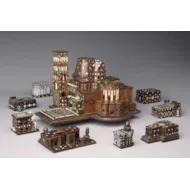
SOLD

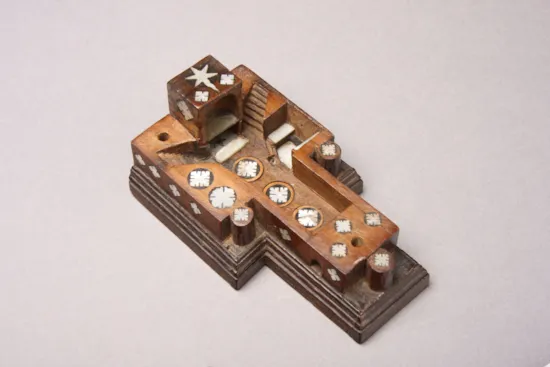
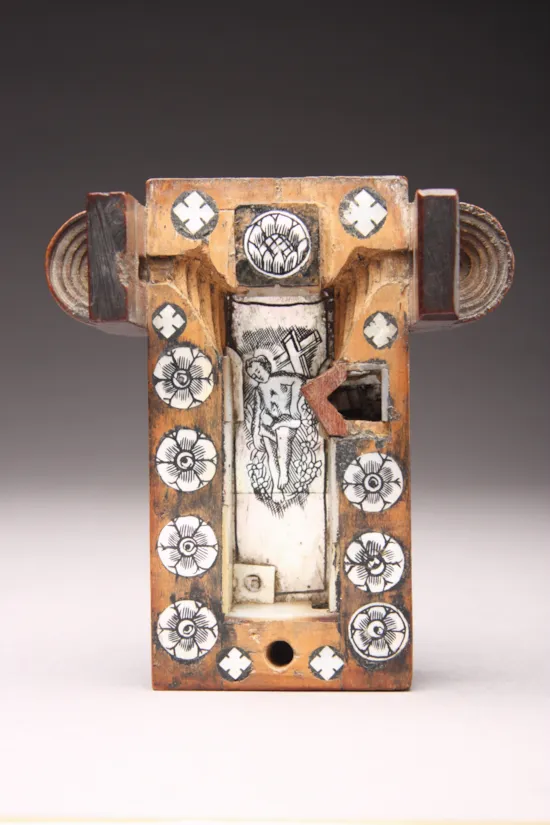
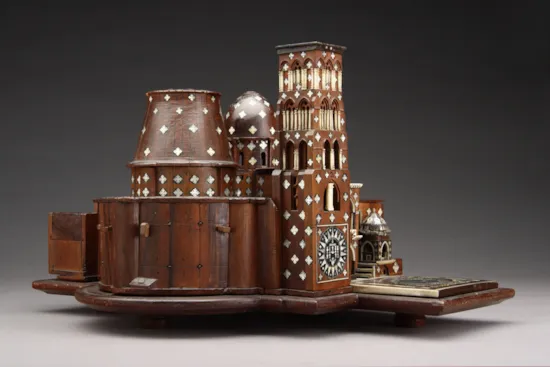

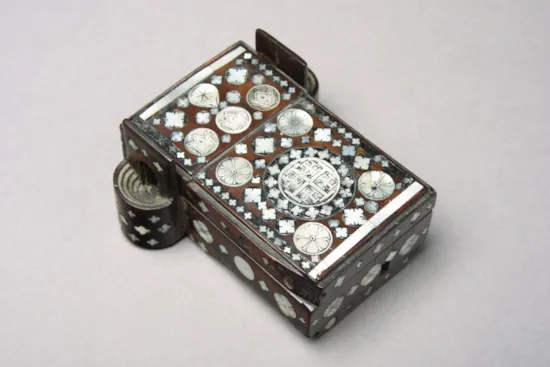
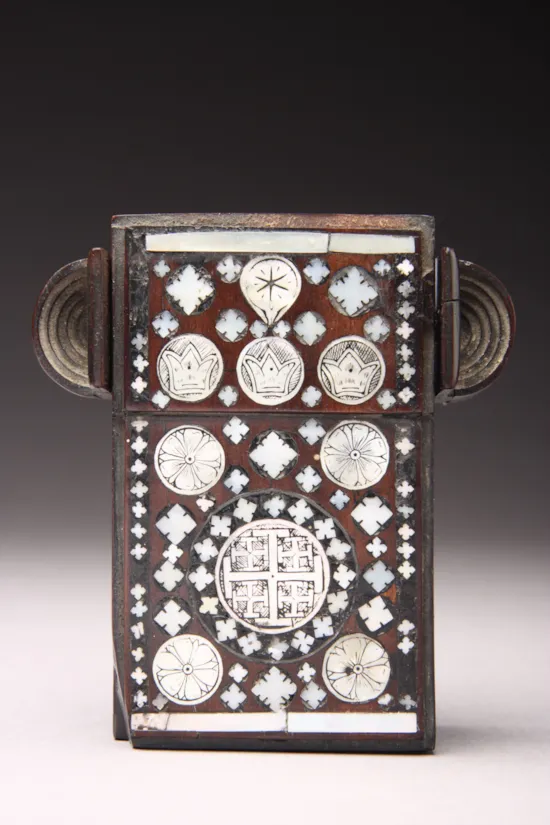
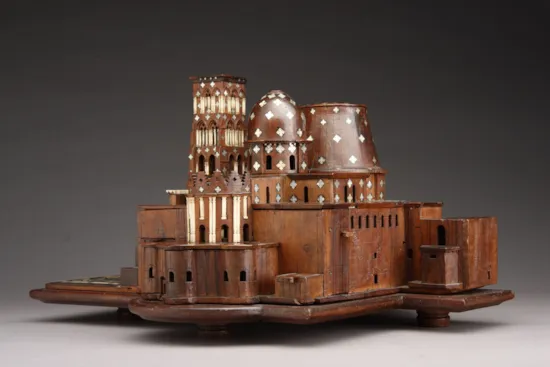
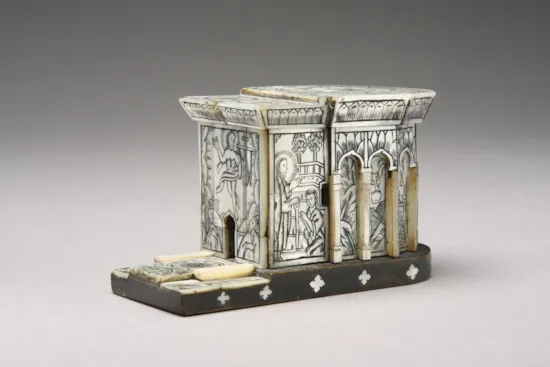
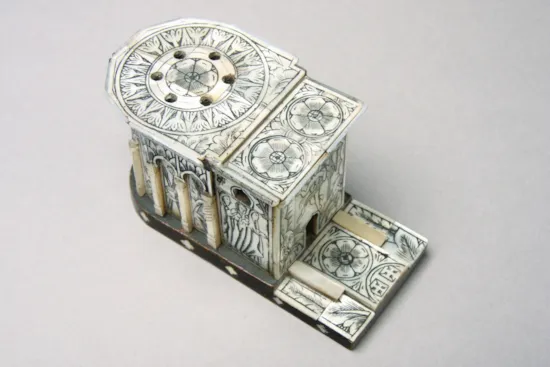
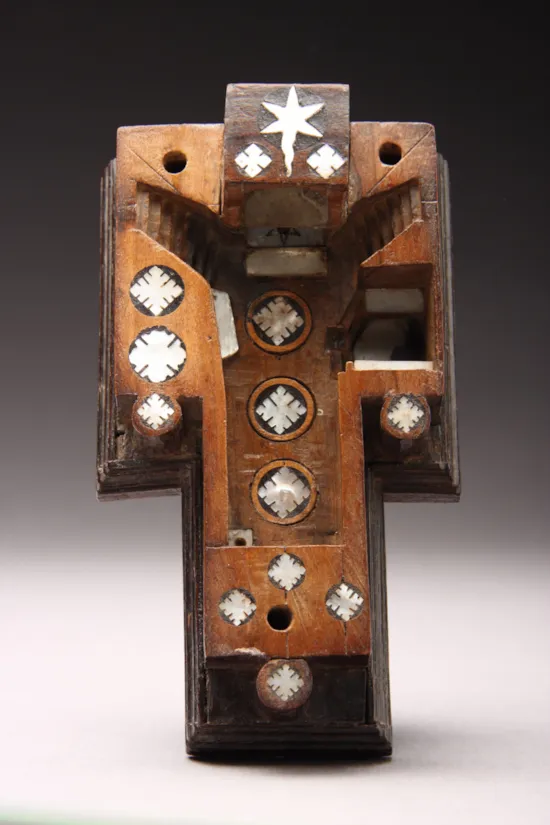
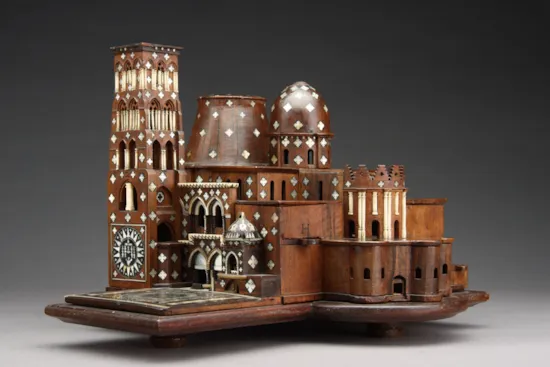

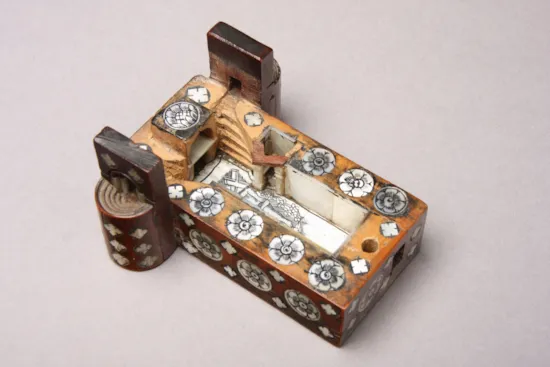
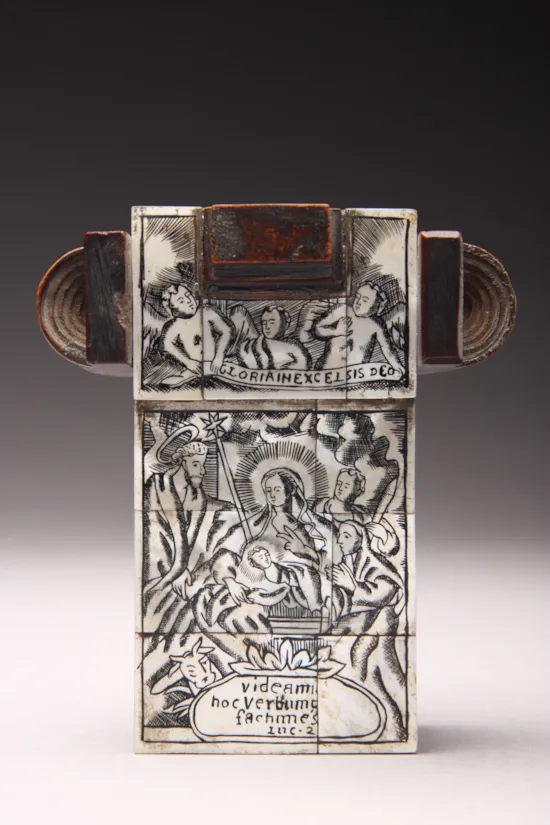
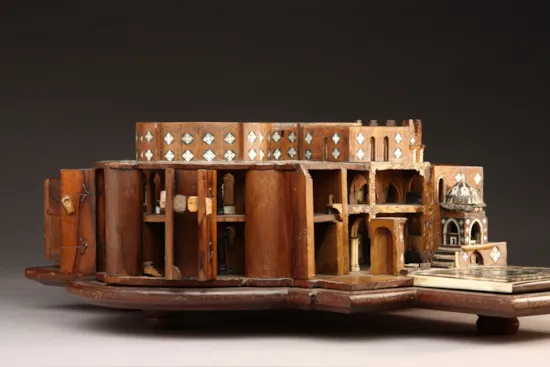

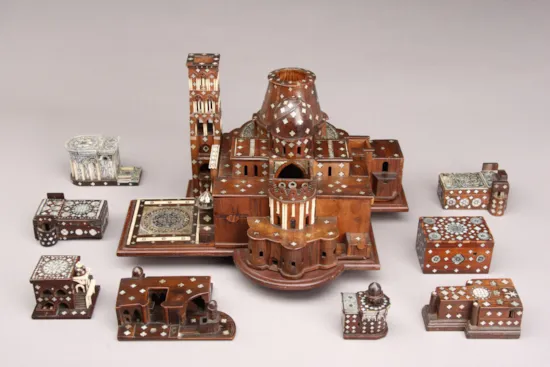
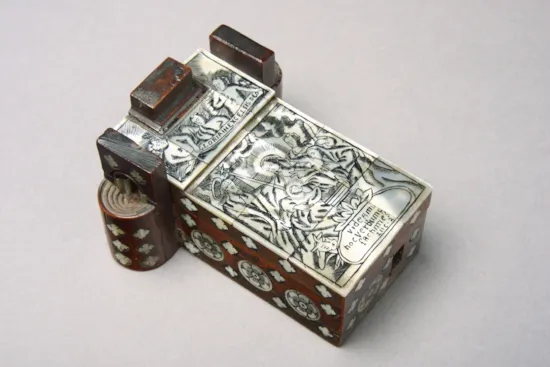
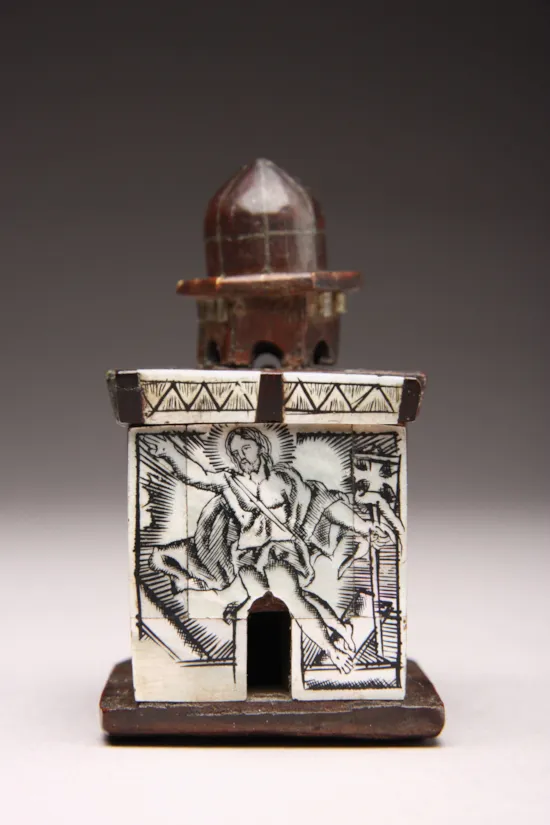
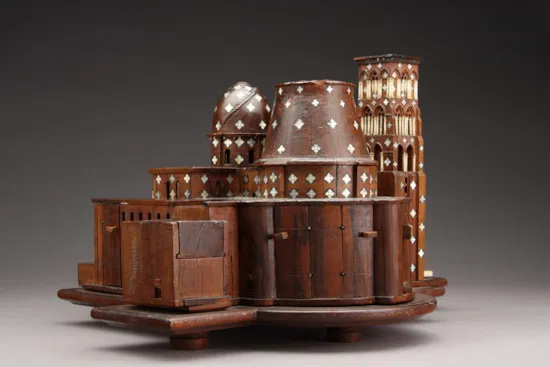
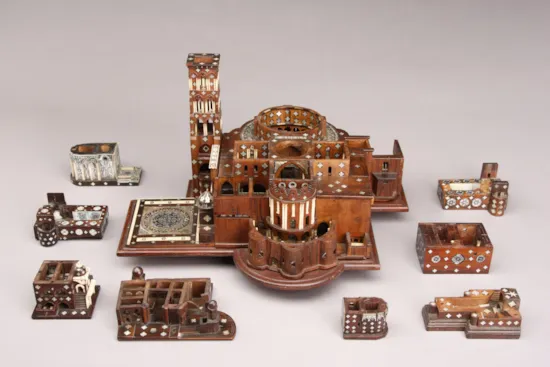
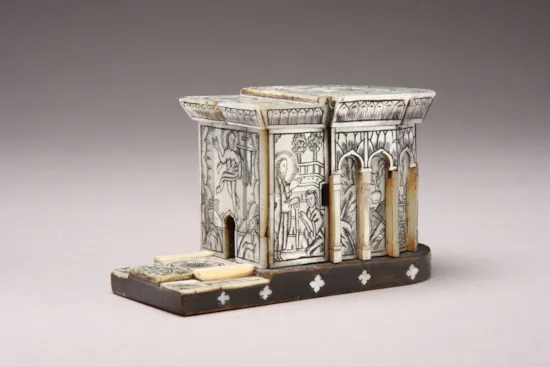
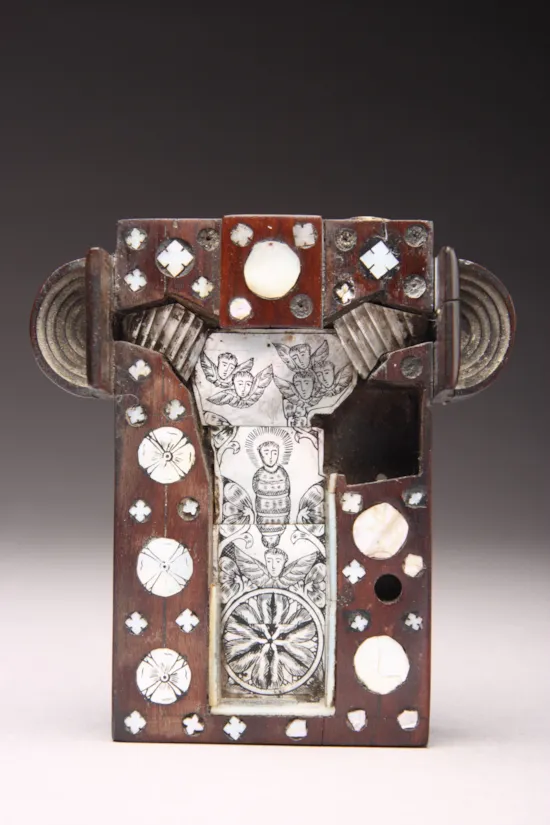
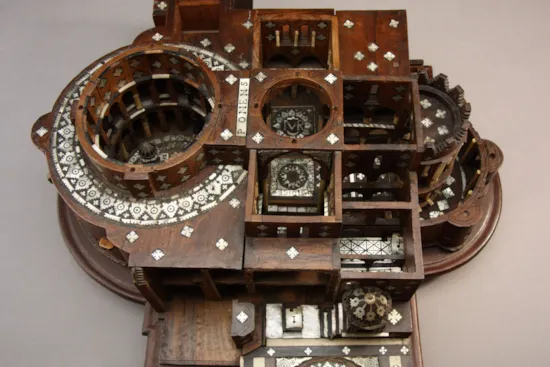

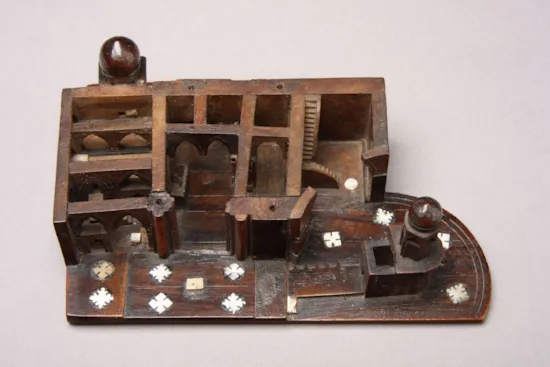
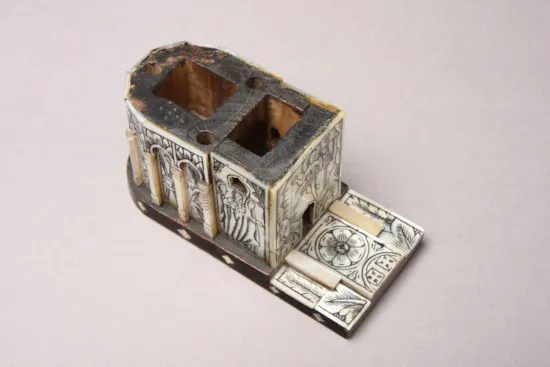
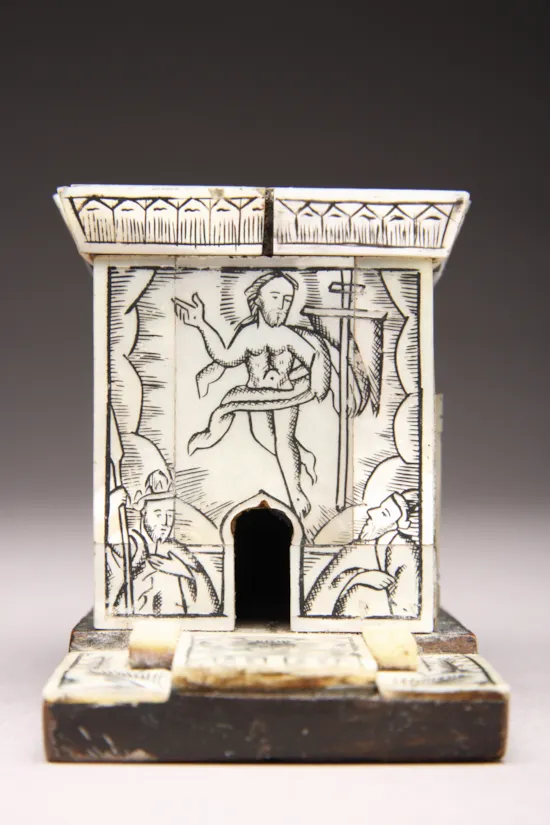
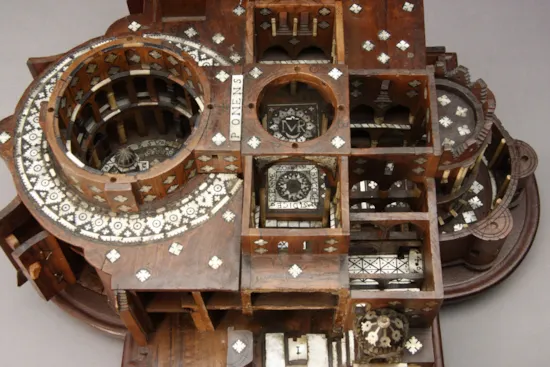
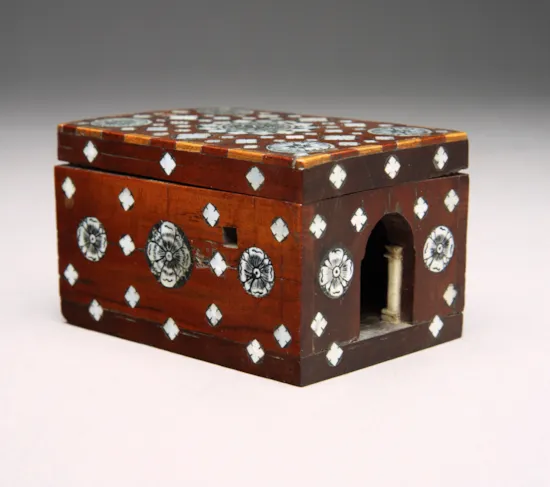
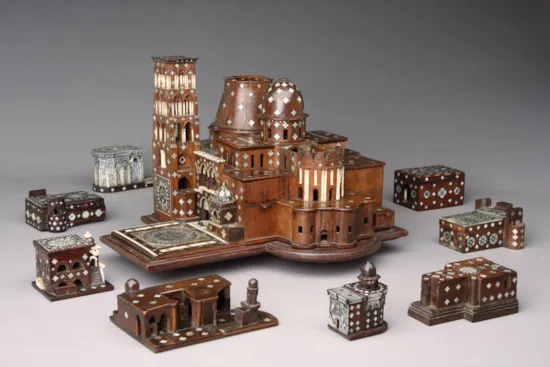
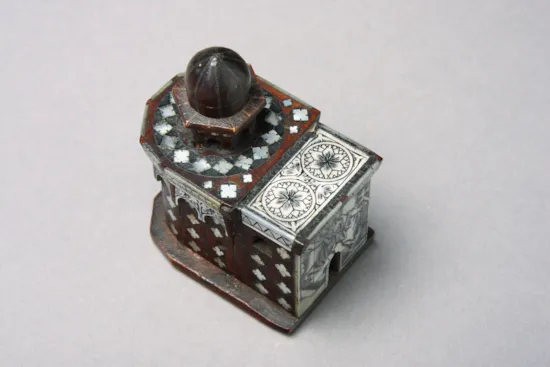
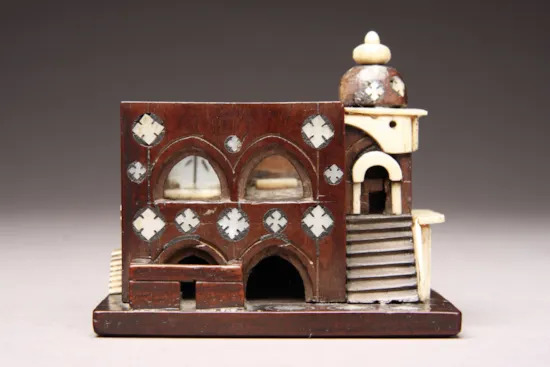
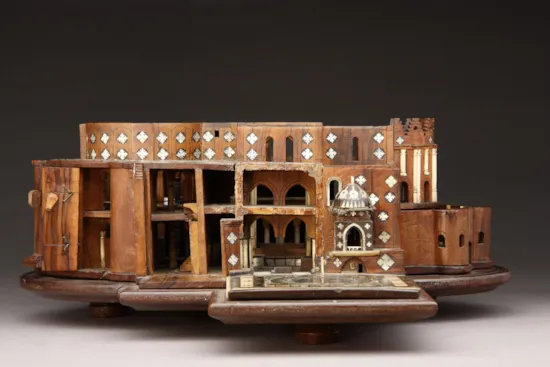
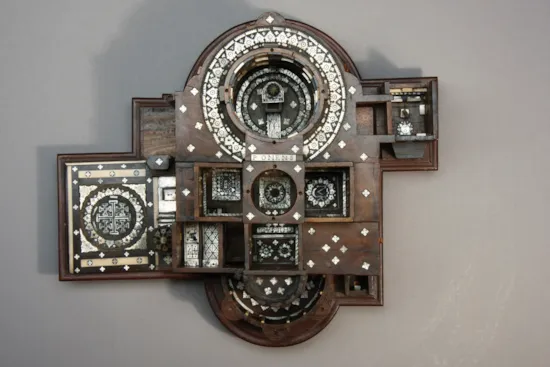
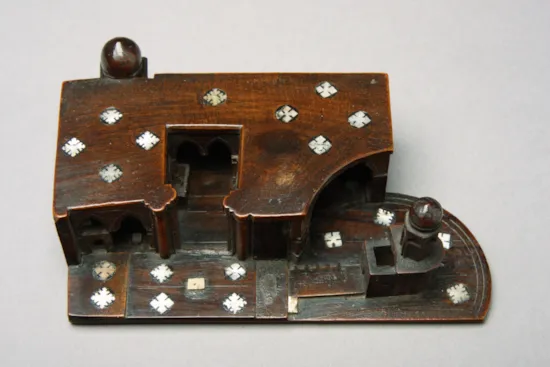
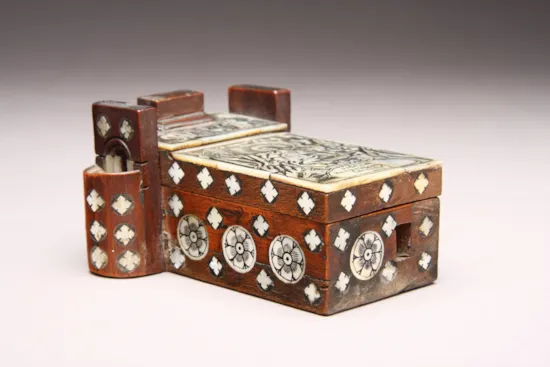
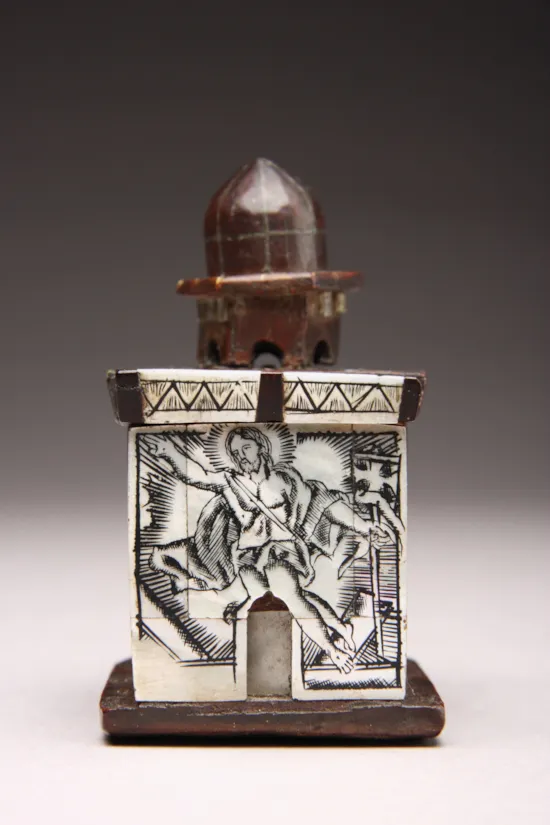
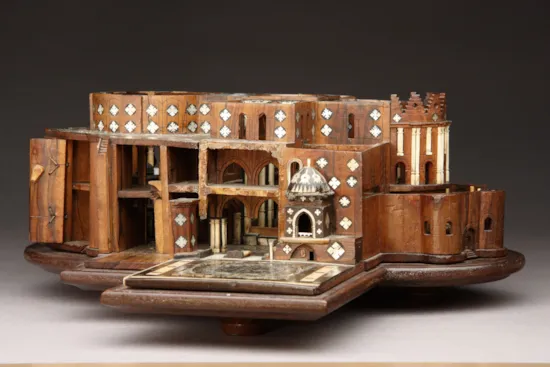
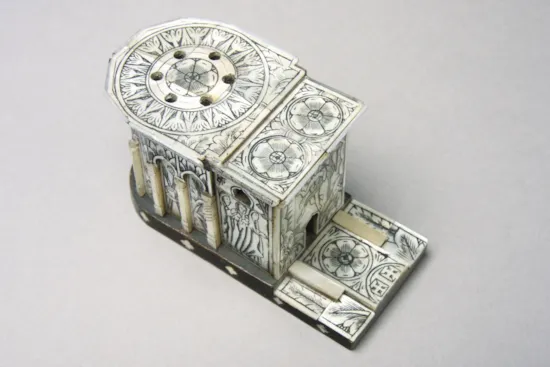

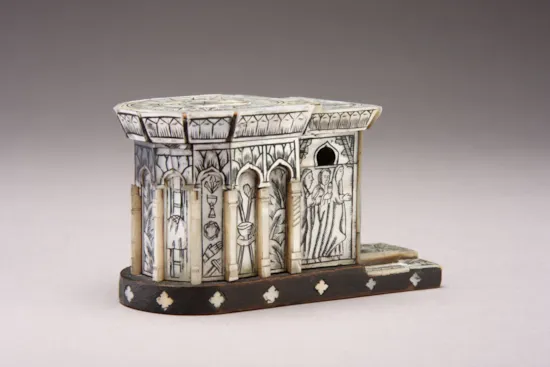
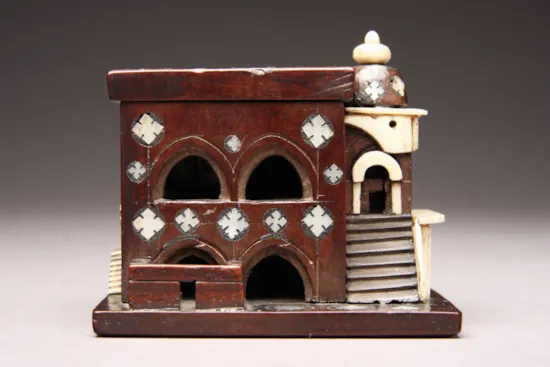
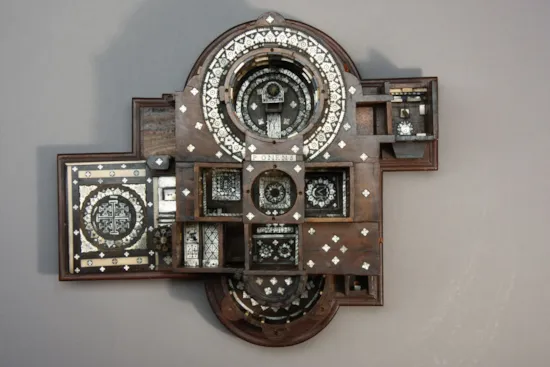
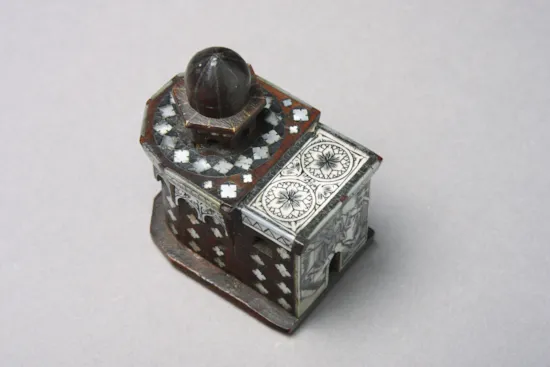
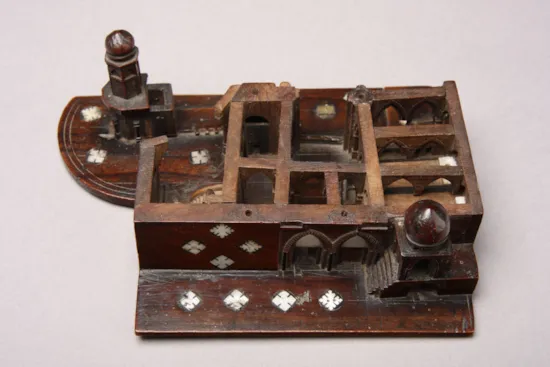
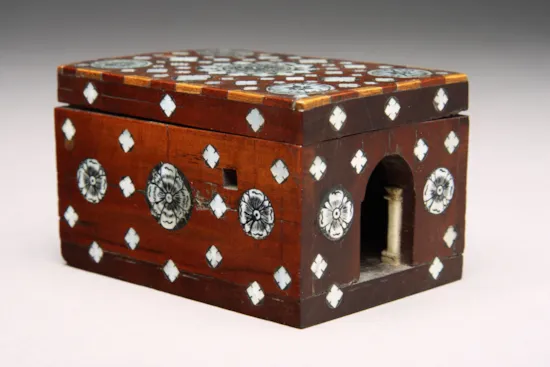
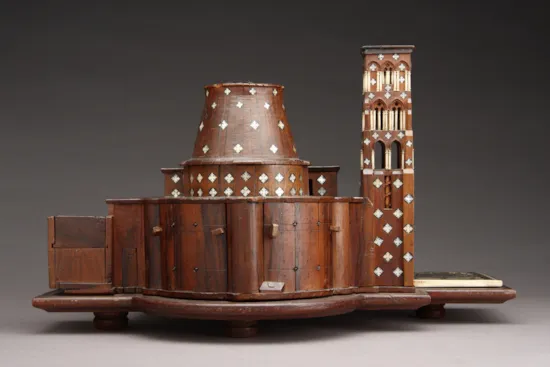

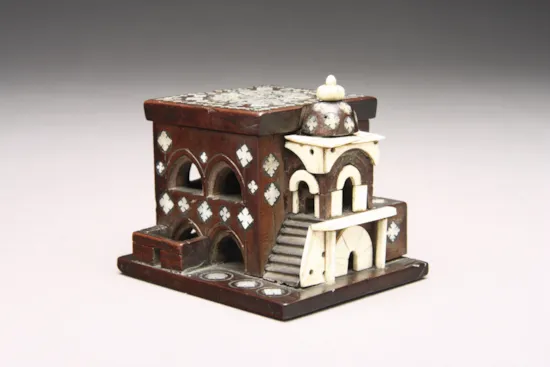
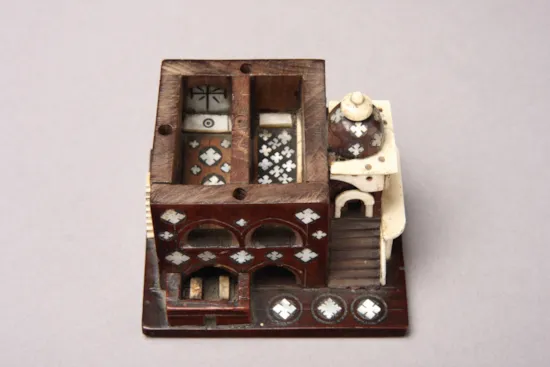
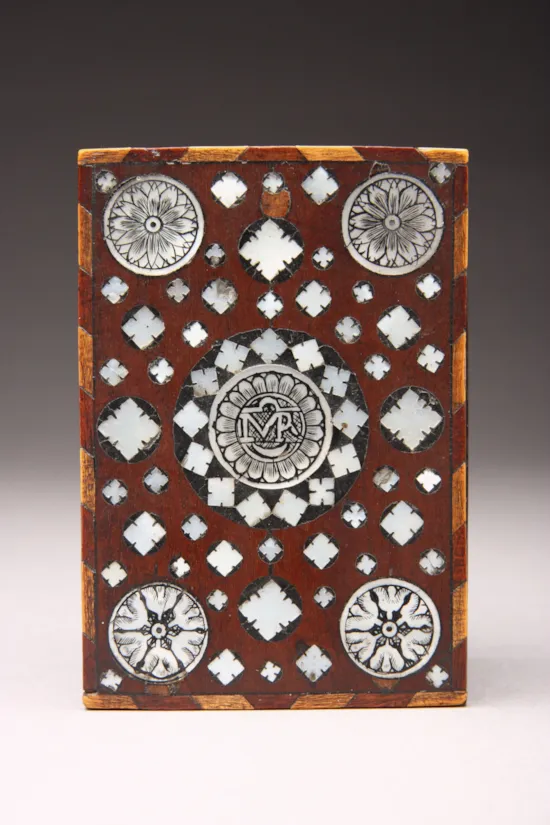

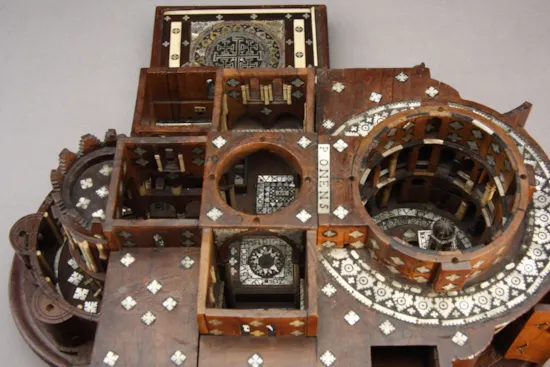
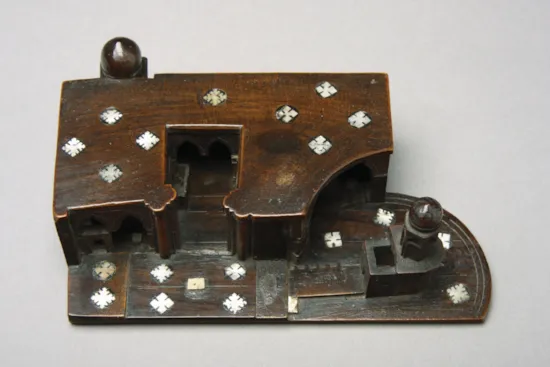
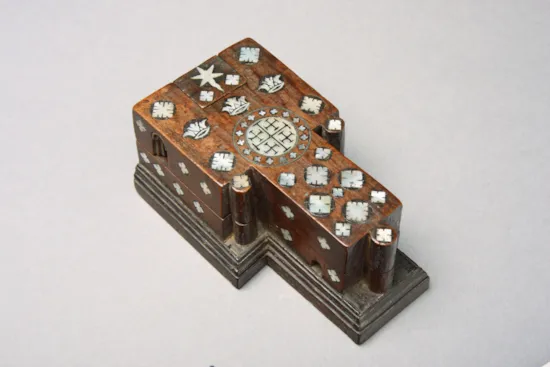
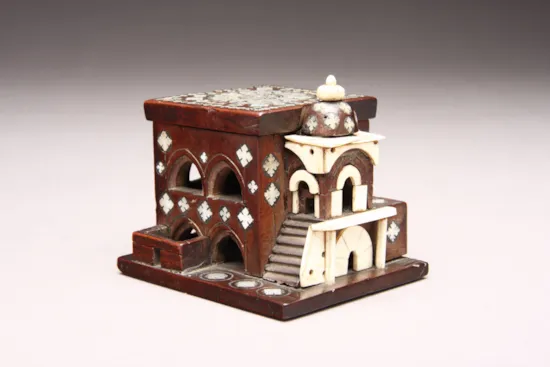
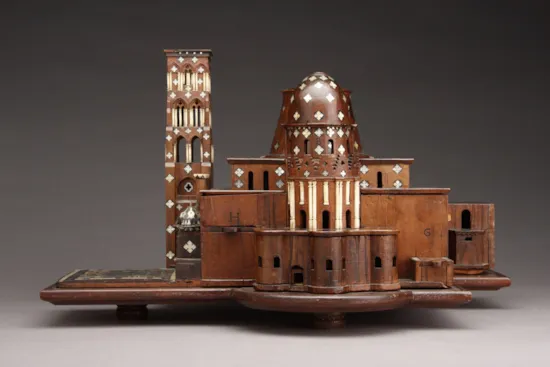
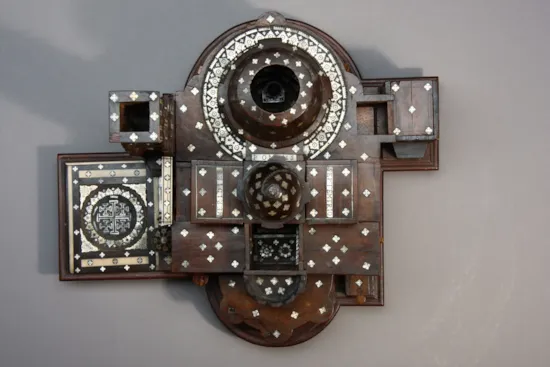
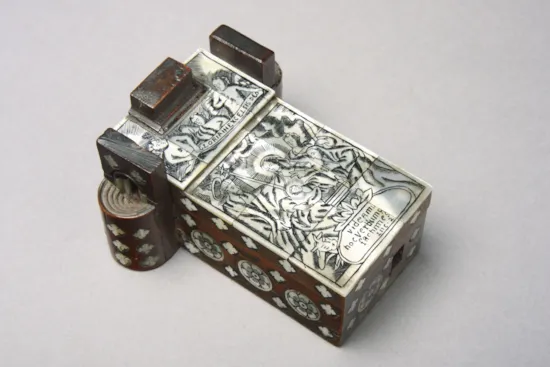
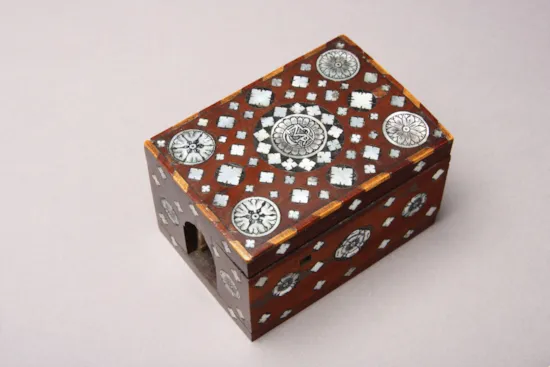
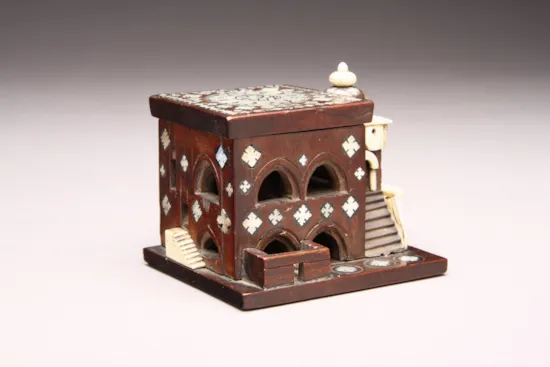
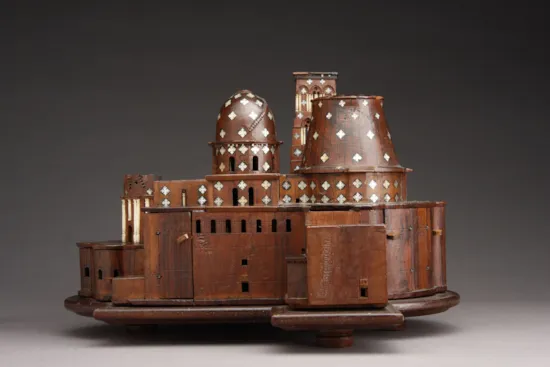
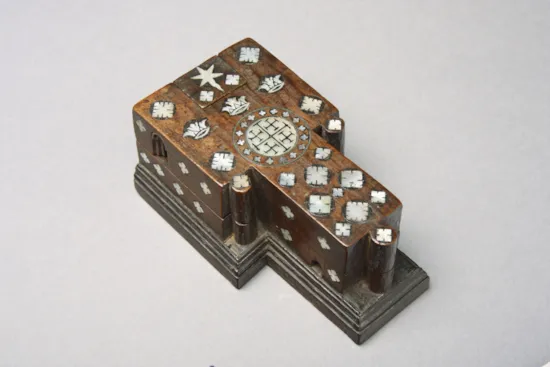
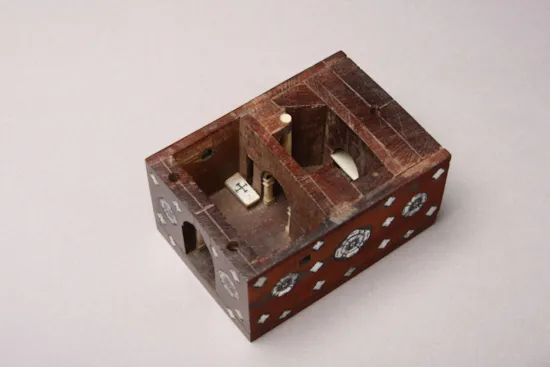
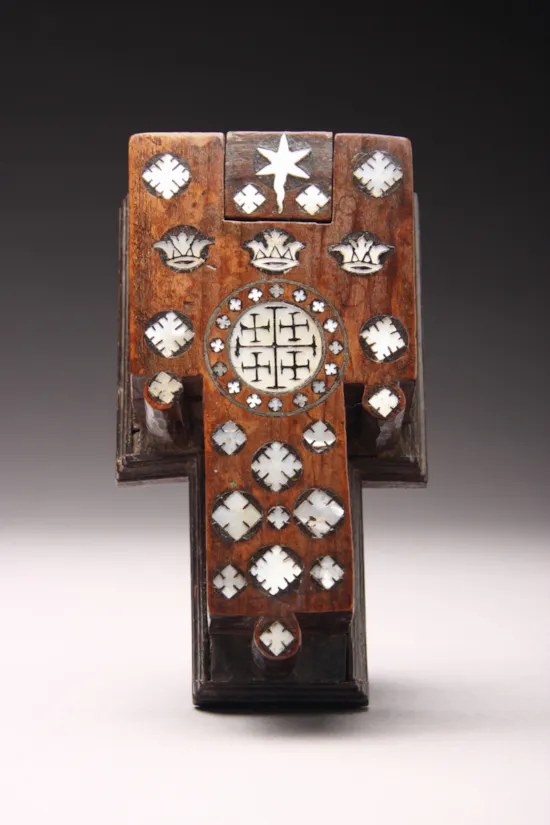
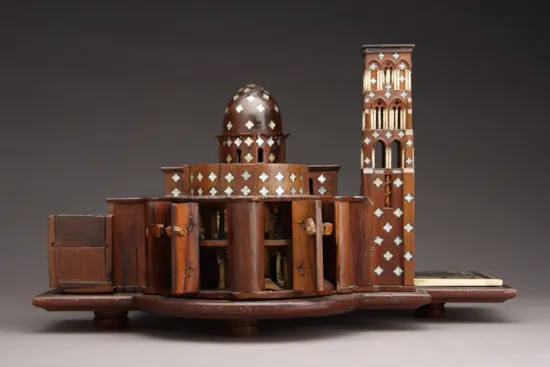
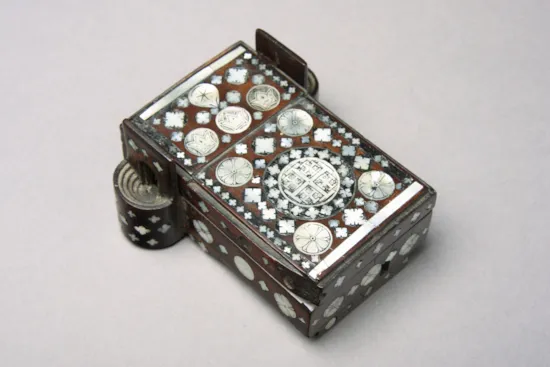
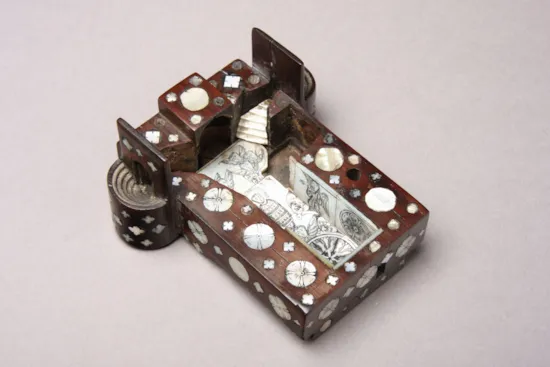
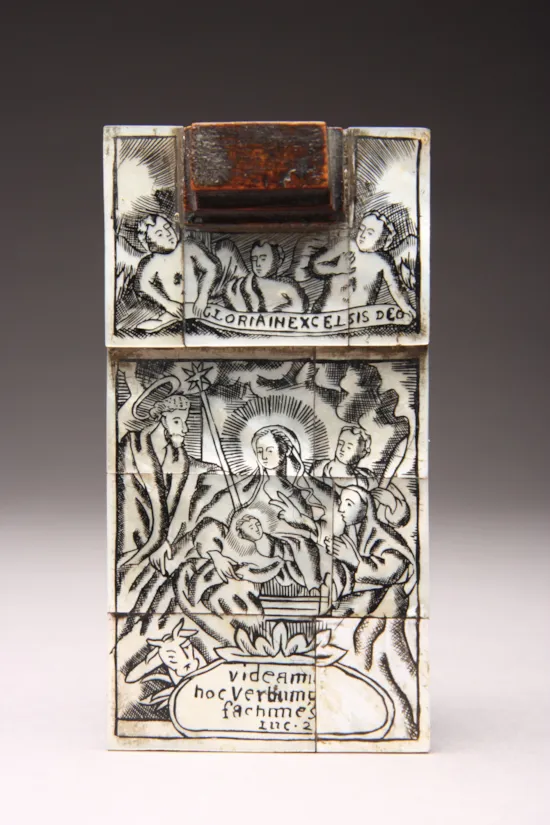









































































YOU MAY ALSO LIKE

